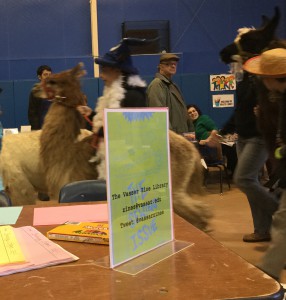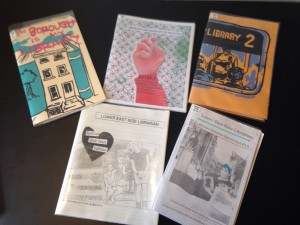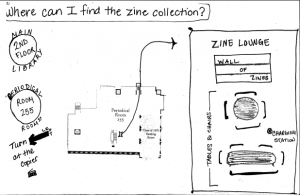Ever wonder what people who spend their days swimming in a sea of literature and information read at home? Wonder no more. The answers might surprise you, the answers might delight you; people who work in libraries are frequently surprising and delightful.
NONFICTION
Bryson, Bill, ed. Seeing Further: The Story of Science, Discovery, and the Genius of the Royal Society. New York: William Morrow, 2011.
Main Q41 .S44 2011
Seeing Further is a collection of essays about the fascinating exploits of the Royal Society featuring pieces by James Gleick, Margaret Atwood, Neal Stephenson, and Richard Dawkins (among many others). The book explores the groundbreaking group from every angle and every era. Illustrations, including reprints of early letters and drawings, really enhance the experience. I’ve just begun reading this book, but so far it’s very intriguing.
— Arianna Schlegel
Jaeger, C. Stephen. Enchantment: On Charisma and the Sublime in the Arts of the West. Philadelphia: University of Pennsylvania Press, 2012.
Art Library NX620.J34 2012
Very much in the vein, and something of a continuation of, Eric Auerbach’s Mimesis. Jaeger is the most important scholar writing on the history of culture in the West in macro terms. His Envy of Angels, about Charismatic culture and education in the 11th and 12th century cathedral schools, is also an essential read for anyone interested in the origins of humanist education.
— Thomas Hill
Keil, Sally Van Wagenen. To Live in the World as Ourselves. New York: Four Directions Press, 2013
Coming soon to the Alumnae Collection
Last year over break, alum Sally Keil ’68, stopped by the library. The book she had just published, To Live in the World as Ourselves has been on my reading list since that conversation. I’m reading it now and enjoying it deeply. The author of the book’s epilogue, Robert A. Johnson, a Jungian Psychologist and author, asserts that “Sally Keil has described the central elements of C.G. Jung’s voyage of discovery of the types and functions of our psychology with deep understanding and inspiration. Her book is a masterpiece. The clarity of her work and its engaging style will make accessible to a wide audience the essence of what Jung worked out over his lifetime.” This book also reminds me of my appreciation for the community of scholars at Vassar and the interesting and inspiring work our students, past and present share with us.
— Carol Lynn Marshall
Kiernan, Denise. The Girls of Atomic City: The Untold Story of the Women Who Helped Win World War II. New York, NY: Simon & Schuster, 2013.
Available via ConnectNY
The Girls of Atomic City is a fascinating collection that combines a series of interviews with the women that worked at the Oak Ridge, TN facility that enriched the uranium that produced the atomic bombs used in WWII. It tackles issues of race, gender, and socioeconomic class while also providing insights into the decision-making processes that the government used to make Oak Ridge come to life. Kiernan uses the “needs to know” dictum of the secrecy of the Army as a leitmotif in the book, slowly revealing more details about the facility and its processes depending on which interviewee she is featuring in each chapter.
— Joanna DiPasquale
Tammet, Daniel. Born on a Blue Day: Inside the Extraordinary Mind of an Autistic Savant, A Memoir. New York: Free Press, 2007.
Main RC553.A88 T36 2007
This is an incredible first-hand account of what it is like to live with autism spectrum disorder (ASD). Tammet’s extraordinary abilities include synesthesia, a highly visual way of thinking that processes concepts such as numbers and letters as colors, shapes, textures, and motions — and the result is that he is a savant particularly for numerical processes. His insights into the way he thinks and how he interacts with others, and how those interactions have changed over time, have been amazing and engaging to read. I read this right after reading Kristine Barnett’s The Spark, about her incredibly gifted and ASD-spectrum son, also a great read.
— Joanna DiPasquale
FICTION
Dicks, Matthew. Something Missing. New York: Broadway Books, 2009.
Available via ConnectNY
So when I asked for book recommendations recently, a friend brought up Something Missing by (the unfortunately named) Matthew Dicks. It’s about a man who makes his living stealing groceries and household goods from a list of “clients”. I had some problems with how the Dicks handled the resolution, but this was still an interesting concept and an overall fun read.
— Julia Yu
Joyce, James. Ulysses. Richmond, U.K.: Alma Classics, 2012 (based on the 1939 Odyssey Press edition).
Main PR6019.O9 U4 2012
Inspired by the Chihuly exhibit and the display of the different Ulysses editions, I’m arduously wending my way through the streets of Dublin and the mind of Leopold Bloom. The book is a big challenge, but one I felt compelled to attempt to flesh out my literary life. (Lots of flesh here.) After reading so much about this “inimitable” and “unreadable” masterpiece, I wanted to check out the words themselves. I confess, I skip over entire incomprehensible sections, and it’s taking me months since I take breaks and clear my mind with friendlier books, but I am getting a cursory feel for what the fuss is about.
— Jo Hausam
Weir, Andy. The Martian. New York : Broadway Books, 2014.
Main Circ, via Kindle PS3623.E446 M37 2014
I wanted to read The Martian after I saw the movie, particularly after realizing that the (albeit fictional) protagonist went to my alma mater, the University of Chicago. Things all made sense after learning that. When you go to a school where the unofficial mottoes are “Where fun comes to die,” and “Hell does freeze over,” you can handle a solitary existence on a distant planet, easy peasy.
— Heidy Berthoud
And last but certainly not least, Rick Riordan!
Three of our contributors suggested Rick Riordan, so it seems that he is a must-read!
Percy Jackson & the Olympians – series. New York: [Disney/Hyperion/Miramax], 2005-2009.
Main PZ7 R4829
When I started reading the Percy Jackson & the Olympians series with my 4th grade step-son, I was excited to find Vassar Library has that series and other titles by Rick Riordan. Percy Jackson’s adventures as a modern demi-god hero are engagingly suspenseful and fun and I reveled in the pantheon of Greek gods and mythology at the heart of the tales. Importantly, I also discovered a great group of Percy Jackson enthusiasts at Vassar among students and non-students; although I’m holding out for students to initiate a Camp Half-Blood style Capture the Flag game to rival Quidditch’s success on college campuses!
— Carol Lynn Marshall
The Heroes of Olympus – series. New York: Disney-Hyperion Books, 2010-2014.
Main PZ7.R4829
I picked up The Lost Hero because I enjoyed the Percy Jackson and The Olympians book series by the same author. From time to time I enjoy reading Young Adult books, good ones are often entertaining and a great distraction!
— Sharyn Cadogan
Magnus Chase and the Gods of Asgard – series. New York: Disney/Hyperion, 2015-??
COMING SOON!
I read The Sword of Summer because I’m trying to read more YA books and I’d already read the Percy Jackson and the Olympians series as well as Heroes of Olympus series.
— Heidy Berthoud



